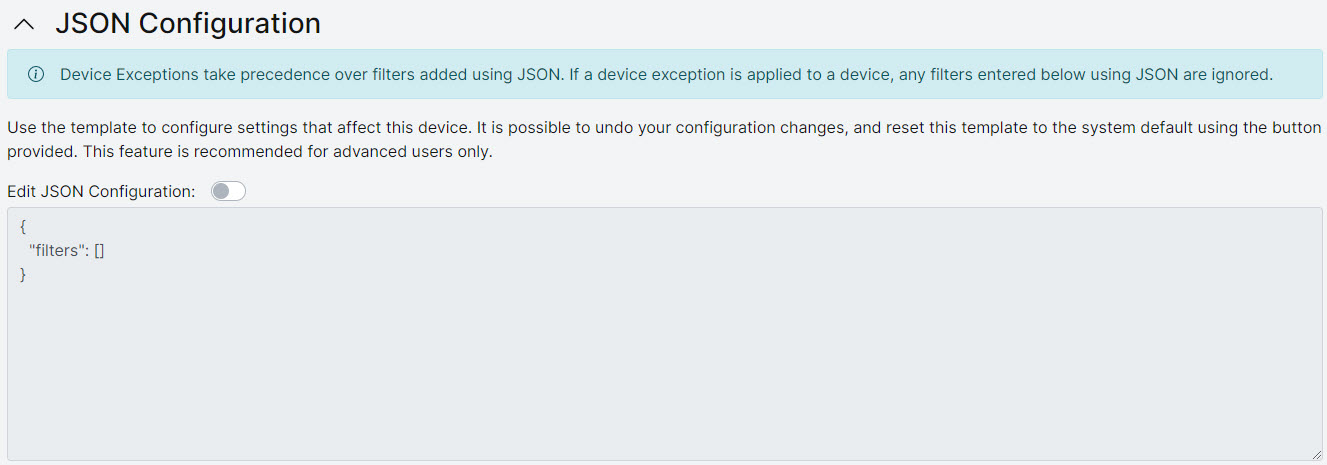Editing Custom JSON Configuration for a Single Device
Custom JSON configuration can be added after OTG installation to handle adjustments to a device other than filters. Filters can be managed from the UI in WebTitan using device exceptions. If a device exception is applied to a device, any filters entered using JSON will be ignored.
Filters are handled using Device Exceptions. See Device Exceptions.
Once saved, any saved custom JSON configuration is pushed out to the device the next time it communicates with WebTitan.
Caution
Custom JSON is recommended for advanced users only. Incorrect JSON configuration can cause a device to stop working, so edit with caution.
Follow the steps below to add custom JSON configuration for a single device.
Go to Environment > Devices and select the device you want to edit. The Device Details page displays.
Scroll to JSON Configuration and select to expand.

Slide the Edit JSON Configuration slider to activate the editor and edit the content.
The content is validated when you save and only valid JSON format is accepted. See https://www.json.org/
 for information on JSON format.
for information on JSON format.When you have finished editing, click Save Changes to save your changes and update the device configuration for this device, or click Reset to revert to the device configuration template.
If saved, the OTG 2 agent syncs with WebTitan every hour to get the latest configuration. OTG will also retrieve the latest configuration following a network change, or following a machine power event.
Custom JSON Configuration Examples
Custom JSON configuration can be added after OTG installation to handle adjustments other than filters to a device. Filters can now be managed from the UI in WebTitan using device exceptions. If a device exception is applied to a device, any filters entered using JSON will be ignored.
See Device Exceptions.
The examples below describe common OTG situations for users and the JSON configuration you can use for that situation.
Warning
Incorrect JSON configuration can cause OTG devices to stop working, so please edit with caution and test carefully.
There is a helpful JSON formatter and validator available at https://jsonformatter.curiousconcept.com/ 
See Editing the Custom JSON Configuration for a Single Device for details on how to view and edit the configuration for a single device.
See Editing the Global Custom JSON Configuration for details on pushing configuration changes out to all devices.
Note
JSON rules accept CIDR notation. For example:
"rule": "203.0.113.0/24"
Example 1: To hide the OTG  icon from the system tray on a user machine after OTG installation.
icon from the system tray on a user machine after OTG installation.
Note
The show/hide system tray feature is available with WebTitan OTG 2 for Windows version 2.0.3 or later.
In the configuration example below, "tray_type" can have the following values:
"hidden": hides the tray icon.
"default": reads the registry value of "hide" or "unhide".
{
"cfg":{
"persistent":{
"key":""
},
"runtime":{
"locations":[
],
"user":"",
"otg":{
"tray_type":"hidden"
}
}
},
"filters":[]}Example 2: If the public IP of a device is 203.0.113.0, use the default machine DNS resolver.
Tip
This filter can be managed from the UI using device exceptions. If a device exception is applied to a device, any filters entered using JSON will be ignored. See Device Exceptions.
{
"filters":[
{
"rule":"203.0.113.0",
"resolvers":[
]
}
]
}Example 3: If the public IP of a device is 203.0.113.0, use 198.51.100.0 as the DNS resolver.
Tip
This filter can be managed from the UI using device exceptions. If a device exception is applied to a device, any filters entered using JSON will be ignored. See Device Exceptions.
{
"filters":[
{
"rule":"203.0.113.0",
"resolvers":[
"198.51.100.0"
]
}
]
}Example 4: If the public IP of a device is either 198.51.100.0 or 56.56.56.57 then use 203.0.113.0 as the DNS resolver.
Tip
This filter can be managed from the UI using device exceptions. If a device exception is applied to a device, any filters entered using JSON will be ignored. See Device Exceptions.
{
"filters":[
{
"rule":"198.51.100.0",
"resolvers":[
"203.0.113.0"
]
},
{
"rule":"56.56.56.57",
"resolvers":[
"203.0.113.0"
]
}
]
}Example 5: If a device is accessing the domain “example.com”, use 203.0.113.0 as the DNS resolver.
Tip
This filter can be managed from the UI using device exceptions. If a device exception is applied to a device, any filters entered using JSON will be ignored. See Device Exceptions.
{
"filters":[
{
"resolvers":[
"203.0.113.0"
],
"domain":"example.com"
}
]
}Example 6: When a device is accessing the domain “example.com”, and the public IP of the device is 203.0.113.0, use 198.51.100.0 as the DNS resolver.
Tip
This filter can be managed from the UI using device exceptions. If a device exception is applied to a device, any filters entered using JSON will be ignored. See Device Exceptions.
{
"filters":[
{
"resolvers":[
"198.51.100.0"
],
"domain":"example.com",
"rule":"203.0.113.0"
}
]
}The IP addresses used in these examples are those reserved for documentation purposes per RFC 5737  .
.